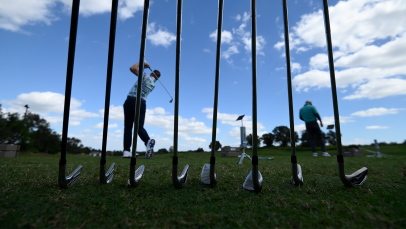Science Lesson
The truth about mud balls

Fred Vuich
My course here in Connecticut opened two weeks ago, a welcome early opportunity to swing the sticks outside instead of in the simulator (sorry, not much of a temporary green kind of guy). Still, it’s been a wet winter and the first 10 days of spring have been no better. That has led to almost every shot resulting in a fair amount of mud being caked on the ball after landing. My foursome decided to combat that by playing lift, clean and place throughout, but it did make me wonder: How much affect does mud really have on a ball?
Certainly, there has been much anecdotal evidence and some attempts at looking at it from a scientific standpoint. Still, when I want science, I want it to be from a Ph.D., not some Bryson DeChambeau wannabe. Luckily, I stumbled upon an article on the topic from Dr. Paul Wood, who joined Ping in 2005 after completing his Ph.D. in Applied Mathematics at University of St. Andrews in Scotland. A research engineer, Wood has extensive expertise in studying the physics of ball flight and the club-ball impact.
Wood was spurred to research the effect and predictability of mud balls after a co-worker encountered a bad mud ball during a tournament and watched the ball fly wildly offline. Unlike many others who opine on the topic, Wood not only has Ping’s knowledge library at his disposal, but a test range complete with the Ping Man robot.

Graphic courtesy of Ping
A theoretical analysis led to a prediction that mud on the right side of the ball should almost always cause the resultant ball flight to curve to the left because mud in the dimples affect the air flow, causing the turbulent wake to be bent toward the mud side. This in turn will cause the ball to curve in the opposite direction. Still, Wood wondered if, during an actual round of golf, with a chunk of mud on the ball, is the effect measurable and repeatable?
A 4-iron was set up on the Ping Man robot and set the swing characteristics to mimic a high swing-speed player. [For the full study, click here] The club speed prior to impact was set to 95 mph, leading to center hits carrying a little more than 220 yards. Several balls with mud caked on different areas were set up. Some had mud covering the entire surface of the ball, while others had mud applied to a specific area: front, back, top, bottom, left or right side of the ball. A healthy amount of mud was applied but most fell off at impact, leaving Wood to reason that smaller amounts would bring similar results.
Of course, everyday golfers don’t want to hear about the science, they just want to know how the ball is going to react. Does it move a certain way consistently? Does it fly shorter? Wood answers those questions with his research.
Wood found balls with mud on the right side landed around 25 yards left of the target on average but with a wide variation in results. With mud on the left, the ball landed almost 30 yards right of the target. With mud all over, the balls went mostly straight but with a similarly wide variation in results. In short and perhaps unsurprisingly, the mud is making the ball flight less consistent.
Now, the general consensus has been that the ball flies in the opposite direction of where the mud is, but Wood’s research shows just how dramatic the effect can be. His research on distance is similarly eye-opening.
While a clean ball hit with a 4-iron at 95 mph goes a little more than 220 yards, but it flies shorter—sometimes considerably so—when mud is applied. With mud on the left or right side, the distance drop is 20-plus yards. If mud is on the back of the ball, the loss is an eye-popping 70 yards. It’s not so bad if the mud is on top of the ball as it is only a 15-yard loss.
Now that score-posting season has started and we can no longer play lift, clean and cheat throughout the course, I know where to aim and to take more club. And now, thanks to a little science experiment, you do, too.


